| 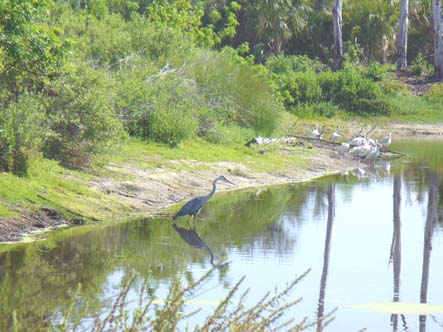
Bringing myself back to
the present, I realize that many things have changed here. Fish still
swim abundantly in this water, but the dark-skinned fisherman can
no longer be seen; nor can the child any longer be heard laughing.
All that remains of the Calusa are traces of daily life found in the
large shell mounds that exist on the shores of Southwest Florida.
Only pieces of their history have been painstakingly excavated from
the archaeological sites found on Pine Island, Mound Key, Estero Bay,
and Everglades National Park.
Researchers hope to learn
more about this extinct indigenous culture by studying the artifacts
they left behind. They hope to gain more of an understanding as to
what this culture, which was the predominant one long ago in this
part of Florida, can teach us about the present, especially about
environmental and ecological issues in this sensitive natural ecosystem.
Bits of shell and gravel crunch under
my feet as I walk along the entrance to the Randell Research Center.
Located at the Pineland Site Complex in Lee County, this research
and education program is operated by the Florida Museum of Natural
History. In 1996, Donald and Patricia Randell donated 53 acres of
land to the University of Florida, and the Research Center was created,
thus establishing a significant focal point for the study of the Calusa.
I approach the newly built visitors
center, anxious to meet Dr. John Worth, an archaeologist and ethno-historian
who coordinates the center's public-education programs and development.
After some initial introductions, we begin a journey on foot through
time along the Calusa Heritage Trail.
This 3700-foot interpretive walkway
leads visitors through the “shell mounds” — among
the most unique and intriguing archeological sites you will find anywhere
— along canals, and in and around numerous other surprising
features of this important Native-American site. Dr. Worth is a dedicated
researcher and scientist with extensive knowledge about the Calusa,
and a passion for telling their story. He explains to me that archaeology
is not an end result, but rather a long continuing process. He also
cautions me that despite our best efforts and best intentions, some
pieces of prehistory may remain hidden forever. I wonder if this is
a good or bad thing.
I am entranced with Dr. Worth’s
narrative abilities, especially his talent for bringing the Calusa
and their culture to life. Gradually I too begin to see them as real
people who were once completely and very successfully integrated into
this wetland ecosystem. Thanks to Dr. Worth, I no longer see the Calusa
as sad statistics from the past; in me he has found captive audience.
With little experience in such matters,
I begin to become aware that archaeology is not just a science of
the mind, but that it is also a science that relies heavily on intuition.
Archaeologists use their logic to decide when, where, why, and how
to dig but often, Dr. Worth tells me, they just have to go with their
gut feelings. And, as we discuss not only the Calusa but the art of
archeology, I discover that there are rarely easy answers to the mysteries
about ancient civilizations like the Calusa. I am also taken aback
when I learn that archaeology can be as disruptive as it can be enlightening.
Despite our different academic backgrounds,
Dr. Worth and I are both in agreement that there are many lessons
to learn about life — both ancient and contemporary —
and that many of these lessons lie just below the surface. And given
the very integrated and shallow wetland environment of this part of
Florida, there is much I learn about the Calusa just by examining
surface features. I forget the oppressive heat as Dr. Worth begins
to tell me the intricate story of the Calusa people and the land and
waters they inhabited.
The Calusa, or “fierce people”
inhabited the inner waterways of this area of Florida for about 1500
years until around the 1700s. They controlled most of southern Florida
under their leader Chief Carlos. Their population numbers may have
reached close to 50,000 when their civilization was at its height.
When Spanish explorers landed in this
area in the early 1500s, they described the Calusa as “fierce”
and “war-like,” and encountered heavy resistance. (I wonder
at the reasons why the Calusa resisted the arrival of the Spanish
and am reminded of the quote “Until lions have their historians,
tales of the hunt shall always glorify the hunter.”)
Juan Ponce de León is considered
to be the man who “discovered” Florida. He also died of
a wound from a Calusa arrow. Much of the information known about the
Calusa are from the writings of the explorer Hernando de Escalante
Fontaneda. In his memoirs, he wrote about his experiences, which included
contact with the Calusa when he was shipwrecked somewhere close to
the Florida Keys at the age of 13. Around 1549 he and his brother
were returning to Spain when they were shipwrecked in the area, possibly
as a result of a hurricane. The crew and passengers were rescued by
the Calusa who subsequently enslaved them. Eventually everyone except
Fontaneda was put to death. According to Fontaneda, his life was spared
because he was able to interpret their commands that he sing and dance
for them. He spent the next 17 years living among them and writing
about their way of life.
The Calusa lived and thrived near the
estuaries of the Caloosahatchee River, the “River of the Calusa,”
nearby what today is Ft. Myers. And it was this unique estuary ecosystem
that contributed to their very successful lifestyle which blended
with the natural elements.
An estuary is a dynamic and fertile
part of a river. As a freshwater river approaches the sea in its lower
course, the salty ocean water and the fresh water mix. It is a mixed,
somewhat contradictory, element but also a place of transition from
land to sea. Protected from the turbulent forces of the ocean environment,
estuaries are in-between aquatic places where unique and abundant
forms of life can thrive.
The estuary environment, along with
Florida’s subtropical coastal environment, provided an abundant
food source for the Calusa. In addition, it was a complex natural
environment in which the Calusa collected herbal medicines and materials
such as palm tree webbing to make nets. Relying entirely on this rich
environment, the Calusa also used spears and fish bone arrowheads
to catch turtles, eels, and deer. For many of us today, the area may
seem an inhospitable, often impenetrable, and exceedingly hot place
to live. But for the Calusa, the necessities of life were close at
hand. Although the primary work of the women consisted of caring for
the children and the home, it was they who caught the abundant shellfish
— crabs, clams, lobsters, oysters — along with the help
of the children. And the remains of their labors can still be seen
today.
The Calusa traveled in canoes made
of hollowed out cypress tree logs through an intricate system of canals
that they built using shells and sticks; an amazing engineering feat
for people who were living directly from their local environment over
1000 years ago — before human beings elsewhere had developed
stone tools. The climate afforded them the luxury of homes that had
no walls, and the roofs were made of palmetto leaves. Built along
the the canals they constructed, the houses were elevated on stilts,
only inches away from their food source. It is believed by some that
they traveled through the protected estuary network and as far as
Cuba. There were even reports that the Calusa attacked Spanish ships
anchored there.
The shell mounds that remain today
are actually piles of refuse; the natural materials the Calusa used
every day and then threw away. According to Dr. Worth, some of the
most revealing information about these people and how they lived comes
from these piles of refuse. Shells were central to their way of life;
from them they made tools, utensils, jewelry, shrines, and ornaments.
Environmentalist and conservation groups protect many of the shell
mounds that remain today because they are a rich source of information.
I find it fascinating that one of the principal activities of visitors
to places in the area such as Sanibel and Captiva Islands is spending
long lazy days collecting shells on the beaches.
Researchers believe that the Calusa
had a fairly complex society. Because of the abundance of resources,
they did not have to spend as much time hunting, gathering, or fishing
as many other native tribes elsewhere did. Their's was not a migratory
lifestyle; there was no need. And one can imagine how strongly they
must have identified with this environment and how protective they
must have been of it.
Being a far more “settled”
people than other indigenous people, they therefore had more time
to develop religious and political systems. The Calusa tribe was divided
into nobles and commoners (and possibly a slave class). There is some
suggestion that they even had an élite force of warriors. They
also had a king. Evidence indicates that they believed in an afterlife,
and had elaborate rituals which included daily offerings, processions
of religious leaders, synchronized singing, and even sacrificial worship.
The number three was a mystical number to them.
Like other native cultures, they had
a hereditary political organization; leaders were not elected, they
were born into their position. As proof of their high status, their
leaders also lived on the highest shell mounds. It was also a patrilineal
society; the eldest son inherited the power when the chief died. The
brother of the chief would become the shaman, or religious leader,
and the chief’s brother-in-law would become the warrior chief.
It was a “family business” that makes me think of other
contemporary political dynasties.
According to the beliefs of the Calusa,
each person had three souls: one was the shadow, one was the reflection,
and one was in the pupil of the eye. In their worldview, when a person
died the soul in the pupil of the eye remained, but the other two
moved into the bodies of animals. This cycle would continue; however
it was a negative chain of evolution. The latter two souls would transmigrate
from large to small animals. The soul was eternal, a continuing part
of nature — and of life.
Although all that Dr. Worth showed
me were really just traces of these people, I came to understand them
as real human beings who “once were.” They impressed me
as innovators in fishing and engineering, people that had faith in
their gods, their government, their people, and their natural home.
They were once like the rest of us. They laughed, loved, prayed, worked,
slept, and ate. They cared for their loved ones, survived harsh environmental
conditions, and continued to prosper for over 1000 years. They fought
for what they felt belonged to them: their land, their families, their
society, and their freedom. They fought and they lost. In the late
1700s, the Calusa people had almost completely disappeared because
of diseases brought by the Europeans, and fighting between the European
explorers as wellas that of rival tribes. A few Calusa escaped to
Cuba, and archeologists are still searching for possible descendants.
All of this left me to consider the
possibility of two truths in this story: that these people were truly
as fierce as the Europeans described them; or that that the Calusa
were protecting what they held most sacred. Perhaps they were who
they were and did what they needed to in order to protect what they
loved. Perhaps, like an estuary, the truth is somewhere in the middle.
It is certainly buried in the tomb-like shell mounds of Southwest
Florida.
As Dr. Worth explained to me, there
is much more to be discovered. However, the excavation of shell mounds
runs the risk of disrupting the very truth we want to uncover.
At the end of my time with Dr. Worth,
and my time among the Calusa, I ponder the mysteries of this extinct
people. Above me in the brilliant blue sky, a hawk cries. I look up.
I know the Calusa still have much to tell us. They too once thought
they would be here indefinitely. Perhaps their souls still are.
|
The
Calusa Indians:
Shell People of the Estuary
by Stephanie Moreland 
The water
slaps the rocks on the shore of the estuary with a cadence that has
been heard by human beings for over 2000 years. In my imagination,
I hear the sounds of a child’s laughter, and see small dark
hands splashing in the water. In my mind’s eye, I see a tall,
bronze-skinned fisherman standing waist deep in the water. His long,
straight black hair hangs around the finely sculpted features of his
face. Creases form at the outer corners of his eyes and on his lips
from long days of working in the sun. His lean, muscular arms strain
under the weight of the net woven of palm leaves.
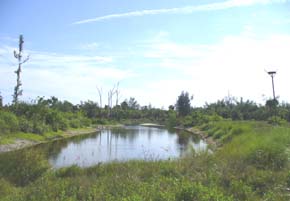
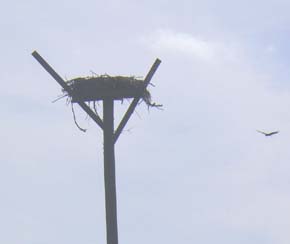
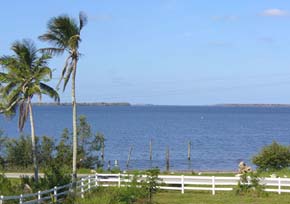
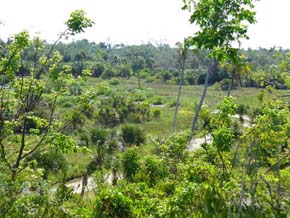
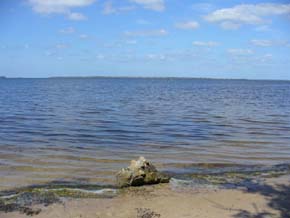
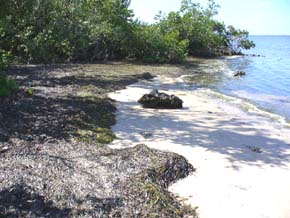
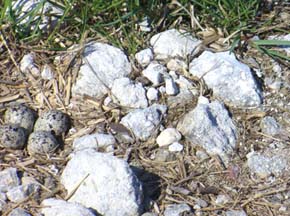
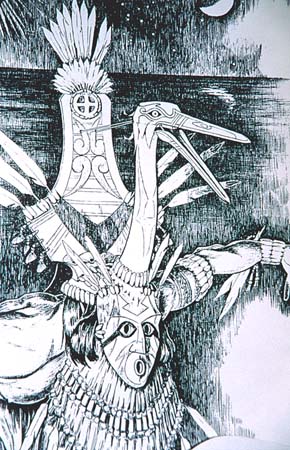
Lee County Visitor & Convention
Bureau
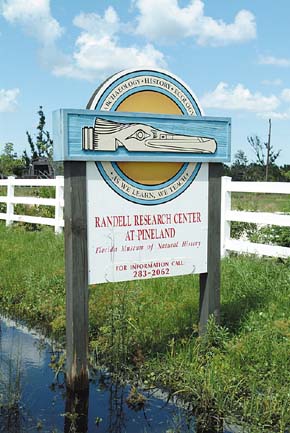
Lee County Visitor & Convention
Bureau
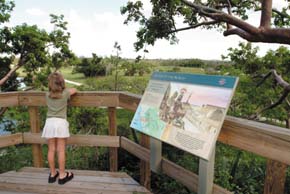
Lee County Visitor & Convention
Bureau
For
more information
The
Randell Research Center
The
Ft. Myers/Sanibel Convention and Visitors Bureau
Specific information about Calusa
history and genealogy:
The
Calusa
Indian History
Calusa-related attractions
The
Calusa Nature Center
and Planetarium
Museum
of the Islands
Calusa Indian Art
Calusa
Indian Art,
Artifacts, & Anecdotes
More on Lee County Florida
The
Bailey-Matthews Shell Museum
Lee
County Living
Unless
otherwise indicated, photographs by Stephanie Moreland |